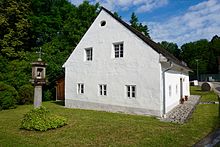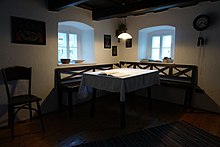Stone crusher house
| Steinbrecherhaus Association (ZVR number: 841127397) |
|
|---|---|
| purpose | Sponsorship, maintenance and operation of the millstone museum Steinbrecherhaus in Perg |
| Chair: | Chairman Harald Marscher |
| Establishment date: | November 30, 2006 |
| Number of members: | around 200 |
| Number of employees: | unsalaried |
| Seat : | Perg |
| Website: | www.steinbrecherhaus.at |
The Steinbrecherhaus millstone museum is a residential building for simple workers that was built at the beginning of the 19th century and is located on the site of the Scherer millstone quarry in the upper forecourt of the town of Perg .
description
The building, erected in 1802, was privately owned until the beginning of the 21st century and was habitable. It was acquired by the Steinbrecherhaus association under chairman Harald Marschner and renovated in 2007, whereby the original condition was largely preserved.
This means that the living conditions of ordinary people can be emulated well. The museum building consists of a room with a table, benches and a tiled stove, a smoking room with simple household appliances and an exhibition room with images, stone objects and tools.
A work hut was originally rebuilt on the associated property and a garden hut with display boards on regional geology was built. In front of it there is a rock garden with work pieces made of sandstone and granite . The terrain extends to the west to the Hinterbach, to which steps lead past an earth cellar. A so-called ram , an old hydraulic pumping station , was put back into operation right by the stream .
With a farmer's mill (Meisingermühle, named after the original installation site at a farmer in Carinthia) that was moved from the Maltatal to Perg in 2019, the stone milling, the grinding of grain, is shown. Millstones made of different stones for different grinding processes show the diversity of grinding that has developed over thousands of years.
Monument protection and award
The quarryer's house, together with the Ratgöbluckn stables carved into sandstone and the museum's open-air mill Scherer millstone quarry, was placed under monument protection in 2009. In 2008, the Steinbrecherhaus Association received the Upper Austrian Folk Culture Prize , because by saving the Steinbrecherhaus a valuable building of old folk architecture could be preserved.
Guild of millstone breakers
The Perg Steinbrecher was first mentioned in a document in 1391. The Perg market owes its origins and prosperity in the Middle Ages to the extraction of millstones from the sandstone. Perger millstones (including those from the Scherer mill quarry ) spread far beyond the borders of Perg. The guild of the millstone breakers comprised 30 to 40 Perg citizens including their assistants and existed until 1859. The guild flag of the Perger millstone breakers is exhibited in the Heimathaus-Stadtmuseum Perg . From 1872 the name Mühlsteinbrecher changed to Mühlsteinhauer .
use
The Steinbrecherhaus millstone museum is used for museum purposes as well as for reading evenings, puppet theater performances, special exhibitions and folk music events. It is located on the Donausteig , is the station of the Perger nature experience spaces and is visited as part of the stone crusher walks of the Perg Local History and Museum Association .
literature
- Franz Moser, Gerhard Pilz: Association Steinbrecherhaus. In: Heimatverein, Stadtgemeinde Perg (Ed.): Heimatbuch der Stadt Perg 2009. Linz 2009, ISBN 978-3-902598-90-5 , p. 403.
- Johann Pree: The Perger millstone crushers. In: Heimatverein Perg, Stadtgemeinde Perg (ed.): Heimatbuch der Stadt Perg 2009. Linz 2009, ISBN 978-3-902598-90-5 , pp. 431-438.
Web links
Individual evidence
- ↑ Mill quarry placed under monument protection
- ↑ Harald Marschner: The Perger Mühlsteinindustrie , in: Webpräsenz der Mühlenfreunde
Coordinates: 48 ° 15 ′ 19.6 ″ N , 14 ° 37 ′ 41.5 ″ E



